The precision blanking dies market is estimated at USD 4,450.6 billion in 2025 and is likely to reach USD 7,821.2 billion by 2035, reflecting a CAGR of 5.8%. The market shows consistent year-on-year growth, starting with USD 4,708.7 billion in 2026 and rising steadily to USD 5,270.8 billion by 2028. Early-stage growth is primarily driven by the adoption of advanced stamping technologies, increased demand in the automotive and electronics sectors, and growing investments in high-precision manufacturing processes.
YoY growth in these years averages around 5.8%, highlighting a stable uptake of precision blanking solutions globally, with manufacturers optimizing production efficiency and reducing material wastage. The global precision blanking dies market is projected to grow from USD 4,450.6 billion in 2025 to approximately USD 7,821.2 billion by 2035, recording an absolute increase of USD 3,370.6 billion over the forecast period.
This translates into a total growth of 75.7%, with the market forecast to expand at a compound annual growth rate (CAGR) of 5.8% between 2025 and 2035. The overall market size is expected to grow by nearly 1.8X during the same period, supported by increasing demand for precision manufacturing, growing adoption of advanced stamping technologies, and rising need for high-quality metal components in the automotive and electronics industries, requiring precise dimensional accuracy and superior surface finish.
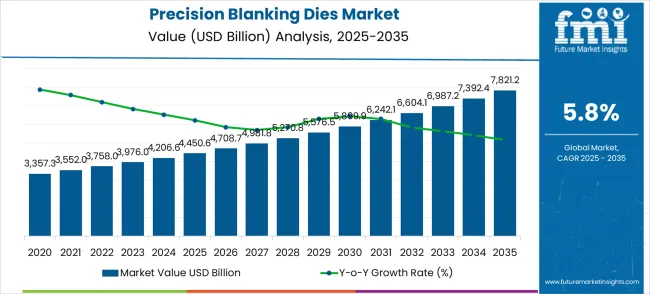
From 2029 to 2032, the market progresses from USD 5,576.5 billion to USD 6,604.1 billion, reflecting both the compounded effect of the base CAGR and incremental adoption of automation technologies in die manufacturing. During this mid-decade period, notable growth is observed in regions with expanding automotive component production, particularly in Asia-Pacific, which contributes significantly to the cumulative market expansion. Investment in smart dies, integrated monitoring systems, and high-performance steels supports enhanced precision, creating measurable growth spikes in 2030 and 2032, where YoY increases slightly exceed the base CAGR, indicating strong demand in specialized manufacturing applications.Between 2025 and 2030, the precision blanking dies market is projected to expand from USD 4,450.6 billion to USD 5,954.8 billion, resulting in a value increase of USD 1,504.2 billion, which represents 44.6% of the total forecast growth for the decade. This phase of growth will be shaped by increasing automotive production requirements, expanding electronics manufacturing, and growing adoption of precision manufacturing technologies. Tooling manufacturers are expanding their precision blanking die portfolios to address the growing demand for high-precision forming solutions with enhanced dimensional accuracy and extended tool life characteristics.
| Metric | Value |
|---|---|
| Estimated Value in (2025E) | USD 4,450.6 billion |
| Forecast Value in (2035F) | USD 7,821.2 billion |
| Forecast CAGR (2025 to 2035) | 5.8% |
Market restraints are observed in 2033–2034, where YoY growth shows slight deceleration relative to previous years, attributed to fluctuations in raw material availability, temporary supply chain disruptions, and global economic slowdowns affecting end-user industries. For example, the market rises from USD 6,987.2 billion in 2033 to USD 7,392.4 billion in 2034, showing a slightly moderated growth rate as manufacturers adjust production strategies in response to higher steel prices and regulatory compliance costs in key regions. These periods highlight the sensitivity of the market to external factors despite the upward trajectory.
The market concludes the forecast period at USD 7,821.2 billion in 2035, demonstrating robust long-term growth. Inflection points are observed in 2028 and 2032, where accelerated adoption of Industry 4.0 technologies and high-strength materials result in pronounced YoY growth. The combination of sustained technological adoption, targeted sector demand, and managed supply chain operations underpins the market dynamics. The market presents a resilient growth pattern with clear opportunities for manufacturers investing in advanced die technologies and strategic regional expansions.From 2030 to 2035, the market is forecast to grow from USD 5,954.8 billion to USD 7,821.2 billion, adding another USD 1,866.4 billion, which constitutes 55.4% of the overall ten-year expansion. This period is expected to be characterized by widespread deployment of Industry 4.0 manufacturing systems, integration with smart factory technologies, and development of next-generation precision forming solutions. The growing demand for miniaturized components and complex geometries will drive adoption of sophisticated precision blanking dies with enhanced capability and automation integration features.
Between 2020 and 2025, the precision blanking dies market experienced steady growth, driven by increasing demand for high-precision metal components and growing recognition of precision blanking advantages over conventional stamping processes. The market evolved as manufacturers recognized the superior dimensional accuracy, surface finish quality, and material utilization efficiency provided by precision blanking technology. Progress in tool materials development and manufacturing processes established the foundation for more durable and precise forming tools across various industrial applications.
Market expansion is being supported by the increasing demand for high-precision metal components that require exceptional dimensional accuracy and surface finish quality beyond the capabilities of conventional stamping processes. Modern manufacturing industries are increasingly focused on forming technologies that can produce complex geometries with tight tolerances while minimizing material waste and secondary operations. The proven capability of precision blanking dies to deliver superior part quality, dimensional consistency, and material efficiency makes them essential tools for advanced manufacturing applications.
The growing emphasis focus on manufacturing efficiency and quality optimization is driving demand for precision forming technologies that can reduce production costs while improving component performance and reliability. Industry preference for forming processes that can eliminate secondary machining operations, reduce material consumption, and provide consistent quality is creating opportunities for precision blanking technology adoption. The rising influence of automotive lightweighting initiatives and electronics miniaturization trends is also contributing to increased demand for precision forming capabilities across different manufacturing sectors and applications.
The market is segmented by classification, application, and region. By classification, the market is divided into engineering molds, continuous molds, and others. Based on application, the market is categorized into consumer electronics, home appliances, hardware, automotives, medical, and others. Regionally, the market is divided into Asia Pacific, North America, Europe, Latin America, and Middle East & Africa.
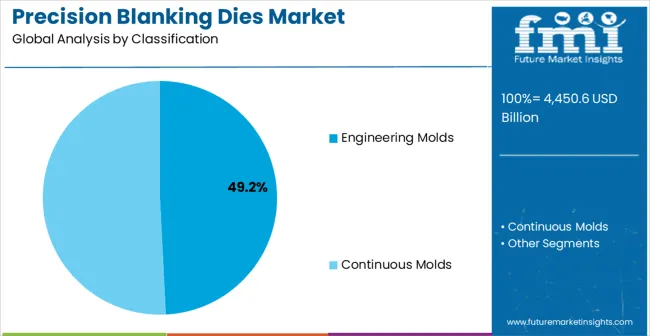
The engineering molds classification is projected to account for 49.2% of the precision blanking dies market in 2025, reaffirming its position as the category's dominant tooling type. Manufacturing engineers increasingly recognize the superior design flexibility and application versatility provided by engineering mold approaches for complex precision blanking operations. This classification addresses the most demanding forming requirements while providing essential customization and optimization capabilities.
This classification forms the foundation of most precision blanking applications, as it represents the most technically sophisticated and application-specific approach for high-precision forming operations. Technology development and design optimization continue to strengthen confidence in engineering mold performance for demanding manufacturing applications. With increasing recognition of the importance of tailored tooling solutions and process optimization, engineering molds align with both current precision requirements and future manufacturing objectives. Their comprehensive capability across multiple forming geometries ensures sustained market dominance, making them the central growth driver of precision blanking die adoption.
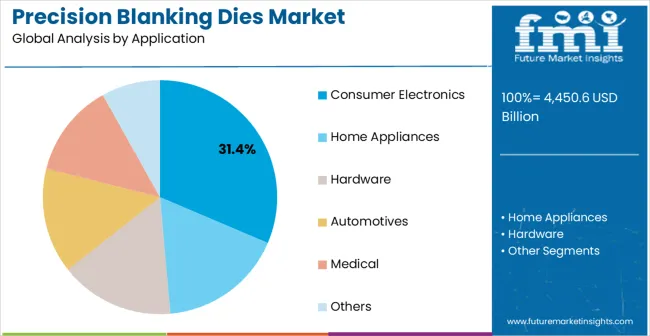
Consumer electronics applications are projected to represent 31.4% of precision blanking dies demand in 2025, underscoring highlighting their role as the primary application driving market development. Electronics manufacturers recognize that miniaturized component production requires the most precise and reliable forming technologies to achieve the dimensional accuracy and surface quality demanded by modern electronic devices. Consumer electronics applications demand exceptional precision and consistency that precision blanking dies are uniquely positioned to deliver.
The segment is supported by the continuous advancement of electronic device miniaturization requiring increasingly precise components and the growing deployment of precision blanking technology across electronics manufacturing facilities. Additionally The , consumer electronics manufacturing is increasingly implementing advanced forming processes that can support both quality requirements and production efficiency objectives. As understanding of electronics manufacturing precision requirements advances, precision blanking applications will continue to serve as the primary commercial driver, reinforcing their essential position within the precision manufacturing technology market.
The precision blanking dies market is advancing steadily due to increasing demand for high-precision manufacturing and growing adoption of advanced forming technologies across various industries. However T, the market faces challenges including high initial tooling costs, complex design requirements, and specialized expertise needs for optimization. Innovation in tool materials and design methodologies continue to influence product development and market expansion patterns.
The growing development of lightweight automotive components and electric vehicle systems is creating enhanced opportunities for precision blanking die integration with advanced material forming applications. Modern automotive manufacturing requires precise forming of high-strength materials and complex geometries that optimize both performance and weight characteristics. Electric vehicle component production provides opportunities for specialized forming processes that can support both structural requirements and electrical functionality.
Modern tooling companies are incorporating premium tool steels, advanced carbide materials, and specialized coating systems to enhance precision blanking die performance and service life. These technologies improve wear resistance, enable extended production runs, and provide enhanced dimensional stability throughout tool operation. Advanced material integration also enables optimized cutting edge geometry and improved forming process reliability.
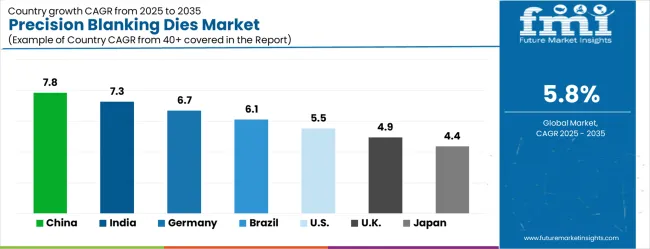
| Country | CAGR (2025-2035) |
|---|---|
| China | 7.8% |
| India | 7.3% |
| Germany | 6.7% |
| Brazil | 6.1% |
| USA | 5.5% |
| UK | 4.9% |
| Japan | 4.4% |
The global market is projected to grow at a CAGR of 5.8% between 2025 and 2035, driven by increasing demand for high-precision metal forming in automotive, electronics, and industrial manufacturing. China leads with 7.8% growth, supported by rapid industrial expansion and adoption of advanced die technologies. India follows at 7.3%, reflecting growing manufacturing capabilities and demand for precision-engineered components. Germany records 6.7%, driven by high-quality automotive and industrial production standards. Brazil is projected at 6.1%, supported by gradual modernization of manufacturing processes and increasing industrial output. The United States grows at 5.5%, influenced by replacement demand and advanced production techniques, while the United Kingdom expands at 4.9% and Japan at 4.4%, reflecting steady adoption in mature and precision-focused manufacturing sectors.The precision blanking dies market is experiencing robust growth globally, with China leading at a 7.8% CAGR through 2035, driven by massive manufacturing sector expansion, government support for advanced manufacturing technologies, and rapidly growing automotive and electronics industries. India follows at 7.3%, supported by expanding manufacturing capabilities, increasing adoption of precision technologies, and growing investment in industrial modernization programs. Germany shows growth at 6.7%, emphasizing precision engineering excellence and comprehensive manufacturing technology leadership. Brazil records 6.1% growth, focusing on expanding industrial manufacturing and growing adoption of advanced forming technologies. The USA shows 5.5% growth, representing steady demand from established manufacturing operations and technology innovation programs.
The report covers an in-depth analysis of 40+ countries; seven top-performing countries are highlighted below.
China is projected to grow at a CAGR of 7.8% from 2025 to 2035, driven by the expanding automotive, electrical, and appliance manufacturing sectors. Precision blanking dies are critical for producing high-accuracy metal parts with reduced material waste and enhanced surface quality. Domestic manufacturers are investing in high-strength tool steels, CNC machining, and automated die manufacturing technologies. Rising production of electric vehicles and smart home appliances is boosting demand for complex stamped components. Industrial clusters in Jiangsu and Guangdong are facilitating high-volume adoption of precision dies. Collaborations with international tooling companies are enhancing design expertise and material innovation, allowing Chinese manufacturers to meet growing domestic and export demand efficiently.
India is expected to grow at a CAGR of 7.3% from 2025 to 2035, supported by growth in automotive, consumer electronics, and industrial machinery manufacturing. Precision blanking dies are increasingly used to produce components with exact tolerances, especially for electric vehicles and high-performance industrial machines. Indian manufacturers are investing in advanced die-making technologies, including laser cutting, EDM, and high-precision stamping. Government initiatives promoting Make in India and automotive component exports are further driving demand. Collaboration with global die makers ensures access to superior materials and design expertise. Tier-1 automotive suppliers and large electronics manufacturers are increasingly adopting precision blanking dies for consistent production quality and reduced cycle times.
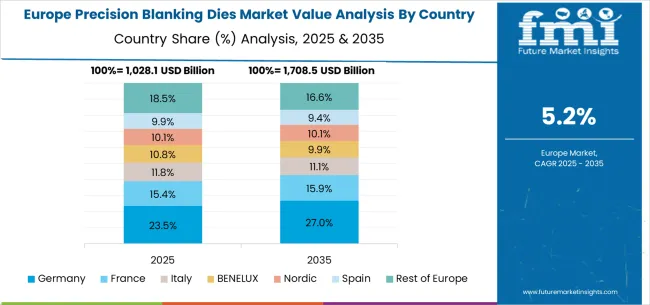
Germany is projected to grow at a CAGR of 6.7% through 2035, fueled by advanced automotive, machinery, and electrical equipment manufacturing. Precision blanking dies are critical in producing high-quality components with minimal material loss and high dimensional accuracy. German manufacturers are integrating advanced tool steels, CNC machining, and automated quality control in die production. Strong automotive clusters in Bavaria and Baden-Württemberg drive high-volume adoption for engines, transmissions, and EV components. Innovation in die coatings and high-speed stamping processes improves durability and productivity. Germany’s focus on industrial automation, robotics, and high-precision production ensures continued demand for advanced blanking dies across automotive and machinery sectors.
Brazil is expected to grow at a CAGR of 6.1% from 2025 to 2035, supported by automotive, aerospace, and machinery manufacturing. Precision blanking dies are increasingly adopted for high-accuracy stamping and consistent component quality. Local manufacturers are investing in durable tool steels and die maintenance solutions to extend service life. Growth in automotive exports, electrical equipment production, and industrial machinery drives demand. Government initiatives to modernize manufacturing infrastructure and support SME tooling companies further stimulate the market. Collaboration with international die manufacturers ensures access to advanced designs, coatings, and production methods for complex component geometries.
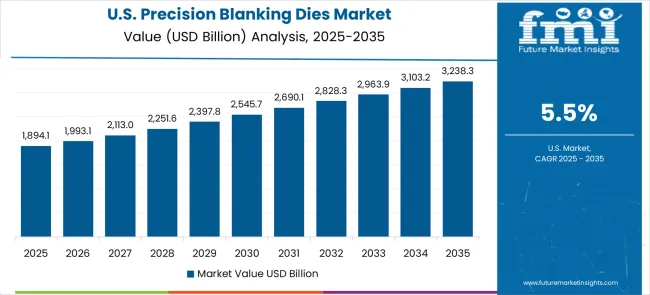
The United States is projected to grow at a CAGR of 5.5% between 2025 and 2035, driven by automotive, aerospace, and electrical equipment industries. Precision blanking dies are widely used to achieve high-dimensional accuracy, reduced scrap, and consistent quality in stamped parts. Domestic manufacturers are focusing on advanced die steels, CNC machining, and automation integration. The expansion of EV production and industrial machinery modernization supports adoption. Aerospace OEMs rely on precision blanking dies for critical components requiring tight tolerances. Partnerships with European and Asian tooling firms provide technological expertise for high-performance die design and coating innovations.
The United Kingdom is projected to grow at a CAGR of 4.9% from 2025–2035, with demand driven by automotive, aerospace, and industrial manufacturing. Precision blanking dies are preferred for high-volume production of critical components with minimal material waste. UK manufacturers are investing in high-strength tool steels, automation, and precision machining to meet industry standards. Adoption is influenced by EV production and aerospace components requiring complex geometries. Collaborations with European tooling companies ensure access to advanced coating and die design technologies. Government-backed industrial modernization programs are further supporting small and medium-sized die makers to upgrade capabilities and productivity.
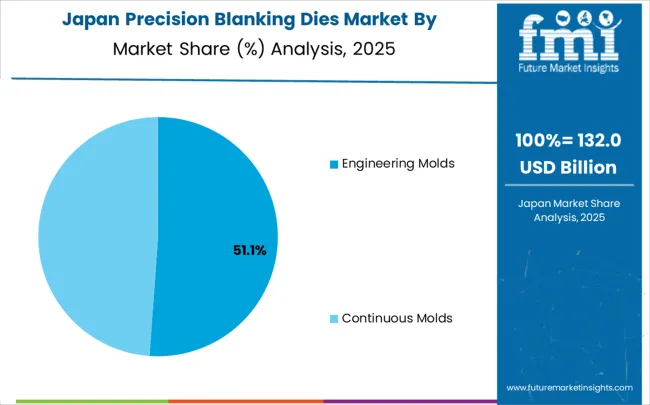
Japan is expected to grow at a CAGR of 4.4% from 2025 to 2035, driven by automotive, robotics, and electrical machinery industries. Precision blanking dies are critical for producing high-accuracy components for EVs, industrial robots, and household appliances. Japanese manufacturers emphasize high-quality tool steels, laser precision, and automated die production for consistent output. Adoption is supported by major automotive clusters in Nagoya and Osaka and ongoing innovation in EV and hybrid vehicle components. Robotics and industrial automation sectors also rely on high-performance dies for compact and precise parts. International collaborations further enhance material quality, coating technologies, and production efficiency.
Revenue from precision blanking dies in China is projected to exhibit outstanding growth with a CAGR of 7.8% through 2035, driven by unprecedented manufacturing sector expansion and comprehensive government support for advanced manufacturing technology development and precision tooling capabilities. The country's dominant position in global manufacturing and increasing adoption of high-precision forming technologies are creating tremendous opportunities for precision blanking die adoption. Major domestic and international tooling companies are establishing comprehensive manufacturing and technology development facilities to serve the rapidly expanding precision manufacturing market.
Government initiatives supporting manufacturing transformation and substantial investment in precision manufacturing infrastructure are driving accelerated adoption of advanced forming technologies throughout major industrial regions.
Manufacturing sector modernization and Industry 4.0 implementation are supporting large-scale deployment of precision blanking dies among leading automotive, electronics, and appliance manufacturers nationwide.
Revenue from precision blanking dies in India is expanding at a CAGR of 7.3%, supported by rapidly growing manufacturing sector, increasing adoption of precision technologies, and expanding investment in industrial automation and modernization programs. The country's substantial manufacturing growth and commitment to technology advancement are driving demand for high-precision forming solutions. International tooling companies and domestic manufacturers are establishing partnerships to serve the growing demand for precision manufacturing technologies.
Rising investment in manufacturing modernization and precision technology adoption are creating significant opportunities for advanced forming solutions across automotive, electronics, and industrial manufacturing sectors.
Growing government support for advanced manufacturing initiatives and technology development is supporting increased adoption of precision blanking dies among manufacturers and tooling providers.
Revenue from precision blanking dies in Germany is projected to grow at a CAGR of 6.7%, supported by the country's leadership in precision engineering and comprehensive expertise in advanced manufacturing technologies. German manufacturers and tooling companies consistently invest in cutting-edge forming technologies and precision manufacturing systems. The market is characterized by engineering excellence, comprehensive quality standards, and established relationships between tooling suppliers and manufacturing users.
Precision engineering leadership and advanced manufacturing excellence are supporting continued investment in precision forming technologies throughout leading manufacturers and tooling providers.
Research institution collaboration and engineering excellence are facilitating advancement of precision blanking applications while ensuring superior performance and manufacturing precision.
Revenue from precision blanking dies in Brazil is projected to grow at a CAGR of 6.1% through 2035, driven by expanding manufacturing sector, increasing adoption of advanced forming technologies, and growing focus on manufacturing precision and efficiency improvement. Brazilian manufacturers are increasingly recognizing the importance of precision forming capabilities in achieving competitive positioning and product quality excellence.
Manufacturing sector expansion and industrial modernization initiatives are supporting increased deployment of precision forming systems across diverse manufacturing applications and industrial sectors.
Growing collaboration between international tooling companies and local manufacturers is enhancing technology adoption and supporting development of domestic precision manufacturing capabilities.
Revenue from precision blanking dies in the USA is projected to grow at a CAGR of 5.5%, supported by established leadership in manufacturing innovation, substantial investment in advanced production technologies, and comprehensive adoption of precision forming systems. American manufacturers and tooling companies consistently advance precision blanking technologies through established innovation programs and technology development initiatives.
Manufacturing technology leadership and industrial innovation are driving continued investment in precision forming systems throughout leading manufacturers and tooling providers.
Technology innovation programs and research collaboration are supporting continued advancement in precision blanking performance and manufacturing application capabilities.
Revenue from precision blanking dies in the UK is projected to grow at a CAGR of 4.9% through 2035, supported by precision manufacturing initiatives and increasing investment in advanced forming technologies. British manufacturers emphasize high-precision forming solutions within comprehensive manufacturing frameworks that prioritize quality excellence and operational efficiency.
Precision manufacturing programs and technology innovation initiatives are supporting systematic adoption of advanced forming technologies across established manufacturing sectors and industrial applications.
Innovation programs and manufacturing excellence initiatives are maintaining high standards for precision forming performance while supporting continued development of advanced manufacturing capabilities.
Revenue from precision blanking dies in Japan is projected to grow at a CAGR of 4.4% through 2035, supported by the country's leadership in precision manufacturing and comprehensive approach to advanced forming technologies. Japanese manufacturers emphasize technology-driven development of sophisticated forming systems within established frameworks that prioritize technical excellence and manufacturing precision.
Advanced manufacturing capabilities and precision engineering expertise are supporting continued leadership in forming technology innovation across leading companies and research institutions.
Industry collaboration initiatives and comprehensive technology standards are maintaining excellence in precision manufacturing applications while supporting commercial success and technology development.
The precision blanking dies market in Europe is projected to expand steadily through 2035, supported by established manufacturing industries, comprehensive precision technology adoption, and ongoing modernization of production facilities. Germany will continue to lead the regional market, accounting for 29.8% in 2025 and rising to 30.6% by 2035, supported by strong precision engineering capabilities, advanced manufacturing infrastructure, and comprehensive tooling technology expertise. The United Kingdom follows with 18.4% in 2025, increasing to 18.7% by 2035, driven by precision manufacturing initiatives, government support for advanced technologies, and expanding industrial automation adoption.
France holds 16.1% in 2025, edging up to 16.4% by 2035 as manufacturers expand precision forming capabilities and demand grows for advanced tooling solutions. Italy contributes 12.7% in 2025, remaining stable at 12.9% by 2035, supported by manufacturing sector strength and growing adoption of precision technologies. Spain represents 9.3% in 2025, moving upward to 9.4% by 2035, underpinned by expanding manufacturing modernization and increasing investment in forming technologies.
Nordic countries together account for 8.9% in 2025, maintaining their position at 9.0% by 2035, supported by advanced manufacturing initiatives and early adoption of innovative forming technologies. The Rest of Europe represents 4.8% in 2025, declining slightly to 3.0% by 2035, as larger markets capture greater investment focus and established manufacturing infrastructure advantages.
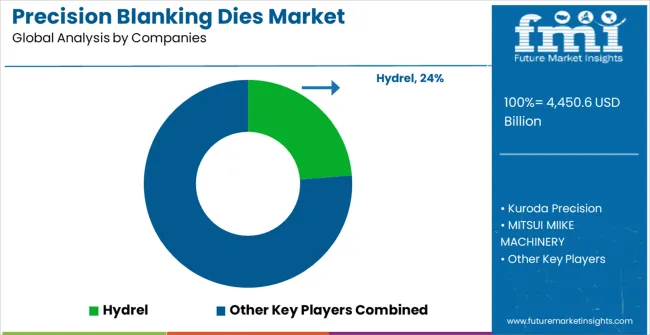
The market is highly competitive, driven by accuracy, material strength, and production efficiency. Hydrel, Kuroda Precision, and MITSUI MIIKE MACHINERY lead with advanced engineering capabilities, precision machining, and durable die materials that ensure consistent performance in high-volume stamping and automotive applications. Their competitive advantage lies in global distribution, stringent quality control, and ability to deliver complex geometries for high-precision manufacturing. Product brochures highlight tolerance accuracy, wear resistance, and die longevity, making these firms preferred partners for OEMs and industrial manufacturers.
AVIC Electromechanical Systems and Ningbo Zhengyu compete by offering high-performance dies with specialized coatings and optimized designs for enhanced cutting precision and reduced maintenance. AVIC emphasizes engineering support and integration with automated production lines, while Ningbo Zhengyu focuses on cost-effective solutions for medium-scale manufacturing operations. Dongguan ZhiHong Precision Mold and Dongguan Jingpin Precision Mold differentiate by providing customized dies for niche applications, including fine stamping and electronic component fabrication, focusing flexibility and rapid prototyping.
Guangdong Rixin High Precision Technology strengthens its position through local market expertise, tailored solutions, and high-quality service support. Product brochures highlight material selection, dimensional accuracy, and adaptability to various stamping presses. Competition in this market is defined by manufacturing precision, material innovation, and responsiveness to client specifications. Leading players invest in advanced machining, surface treatment technologies, and design optimization, while regional manufacturers leverage cost efficiency and customization to capture emerging opportunities, maintaining a balanced yet technology-driven competitive landscape.The precision blanking dies market is characterized by competition among specialized tooling manufacturers, established precision engineering companies, and innovative forming technology providers. Companies are investing in advanced tool materials, design optimization, strategic partnerships, and manufacturing excellence to deliver high-performance, reliable, and cost-effective precision blanking die solutions. Technology development, quality assurance, and customer support strategies are central to strengthening competitive advantages and market presence.
Hydrel leads the market with significant expertise in precision forming technologies, offering comprehensive precision blanking die solutions with focus on dimensional accuracy and manufacturing excellence. Kuroda Precision provides established precision tooling capabilities with emphasis on advanced engineering and quality optimization. MITSUI MIIKE MACHINERY focuses on comprehensive forming equipment and tooling solutions with advanced manufacturing capabilities. AVIC Electromechanical Systems delivers advanced manufacturing technologies with strong focus on precision tooling applications.
Ningbo Zhengyu operates with focus on precision tooling manufacturing and comprehensive quality systems. Dongguan ZhiHong Precision Mold specializes in precision mold technologies with emphasis on consumer electronics and automotive applications. Dongguan Jingpin Precision Mold provides comprehensive precision tooling solutions with focus on manufacturing excellence. Guangdong Rixin High Precision Technology focuses on high-precision manufacturing capabilities and advanced tooling technologies to enhance overall market development and precision forming capability advancement.
| Items | Values |
|---|---|
| Quantitative Units (2025) | USD 4,450.6 bBillion |
| Classification | Engineering Molds, Continuous Molds, Others |
| Application | Consumer Electronics, Home Appliances, Hardware, Automotives, Medical, Others |
| Regions Covered | Asia Pacific, North America, Europe, Latin America, Middle East & Africa |
| Countries Covered | China, India, Germany, Brazil, United States, United Kingdom, Japan and 40+ countries |
| Key Companies Profiled | Hydrel, Kuroda Precision, MITSUI MIIKE MACHINERY, AVIC Electromechanical Systems, Ningbo Zhengyu, Dongguan ZhiHong Precision Mold, Dongguan Jingpin Precision Mold, Guangdong Rixin High Precision Technology |
| Additional Attributes | Dollar sales by die type and application, regional adoption trends, competitive landscape, manufacturing partnerships, integration with forming systems, innovations in tool materials and design, precision analysis, and manufacturing efficiency optimization strategies |
The global precision blanking dies market is estimated to be valued at USD 4,450.6 billion in 2025.
The market size for the precision blanking dies market is projected to reach USD 7,821.2 billion by 2035.
The precision blanking dies market is expected to grow at a 5.8% CAGR between 2025 and 2035.
The key product types in precision blanking dies market are engineering molds and continuous molds.
In terms of application, consumer electronics segment to command 31.4% share in the precision blanking dies market in 2025.






Our Research Products

The "Full Research Suite" delivers actionable market intel, deep dives on markets or technologies, so clients act faster, cut risk, and unlock growth.

The Leaderboard benchmarks and ranks top vendors, classifying them as Established Leaders, Leading Challengers, or Disruptors & Challengers.

Locates where complements amplify value and substitutes erode it, forecasting net impact by horizon

We deliver granular, decision-grade intel: market sizing, 5-year forecasts, pricing, adoption, usage, revenue, and operational KPIs—plus competitor tracking, regulation, and value chains—across 60 countries broadly.

Spot the shifts before they hit your P&L. We track inflection points, adoption curves, pricing moves, and ecosystem plays to show where demand is heading, why it is changing, and what to do next across high-growth markets and disruptive tech

Real-time reads of user behavior. We track shifting priorities, perceptions of today’s and next-gen services, and provider experience, then pace how fast tech moves from trial to adoption, blending buyer, consumer, and channel inputs with social signals (#WhySwitch, #UX).

Partner with our analyst team to build a custom report designed around your business priorities. From analysing market trends to assessing competitors or crafting bespoke datasets, we tailor insights to your needs.
Supplier Intelligence
Discovery & Profiling
Capacity & Footprint
Performance & Risk
Compliance & Governance
Commercial Readiness
Who Supplies Whom
Scorecards & Shortlists
Playbooks & Docs
Category Intelligence
Definition & Scope
Demand & Use Cases
Cost Drivers
Market Structure
Supply Chain Map
Trade & Policy
Operating Norms
Deliverables
Buyer Intelligence
Account Basics
Spend & Scope
Procurement Model
Vendor Requirements
Terms & Policies
Entry Strategy
Pain Points & Triggers
Outputs
Pricing Analysis
Benchmarks
Trends
Should-Cost
Indexation
Landed Cost
Commercial Terms
Deliverables
Brand Analysis
Positioning & Value Prop
Share & Presence
Customer Evidence
Go-to-Market
Digital & Reputation
Compliance & Trust
KPIs & Gaps
Outputs
Full Research Suite comprises of:
Market outlook & trends analysis
Interviews & case studies
Strategic recommendations
Vendor profiles & capabilities analysis
5-year forecasts
8 regions and 60+ country-level data splits
Market segment data splits
12 months of continuous data updates
DELIVERED AS:
PDF EXCEL ONLINE
Precision Livestock Farming Market Size and Share Forecast Outlook 2025 to 2035
Precision Wire Drawing Service Market Size and Share Forecast Outlook 2025 to 2035
Precision Planting Market Size and Share Forecast Outlook 2025 to 2035
Precision Bearing Market Size and Share Forecast Outlook 2025 to 2035
Precision Laser Engraving Machines Market Size and Share Forecast Outlook 2025 to 2035
Precision Analog Potentiometer Market Size and Share Forecast Outlook 2025 to 2035
Precision Components And Tooling Systems Market Size and Share Forecast Outlook 2025 to 2035
Precision Chemicals Market Size and Share Forecast Outlook 2025 to 2035
Precision Fermentation Ingredients Market Size and Share Forecast Outlook 2025 to 2035
Precision-Fermented Casein for QSR Pizza Cheese Market Analysis - Size, Share, and Forecast Outlook 2025 to 2035
Precision Ruminant Minerals Market Analysis - Size and Share Forecast Outlook 2025 to 2035
Precision Forestry Market Size and Share Forecast Outlook 2025 to 2035
Precision Stainless Steel Market Size and Share Forecast Outlook 2025 to 2035
Precision Machine For Polymers Market Size and Share Forecast Outlook 2025 to 2035
Precision Aquaculture Market Size and Share Forecast Outlook 2025 to 2035
Precision Fermented Functional Lipids Market Analysis Size and Share Forecast Outlook 2025 to 2035
Precision Gearbox Machinery Market Trends and Forecast 2025 to 2035
Precision Cancer Imaging Market Growth - Industry Trends & Forecast 2025 to 2035
Precision Poultry Nutrition Market – Growth, Demand & Livestock Trends
Precision Agriculture Market

Thank you!
You will receive an email from our Business Development Manager. Please be sure to check your SPAM/JUNK folder too.
Chat With
MaRIA